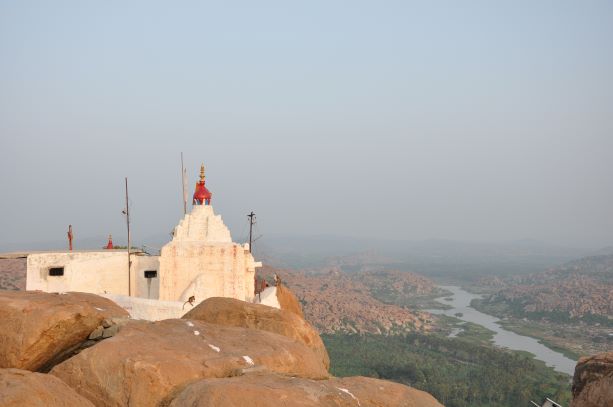Association of Sri Hanuman Ji with Karnataka Region

After being exiled for fourteen years from Ayodhya, Ram, Sita and Lakshman first arrived at Chitrakut and stayed there for some years as per descriptions found in Ramayan. Thereafter they must have traversed Jharkhand’s forested areas and thereafter Chhattisgarh, which was then known as Dandakaranya. Finally, they must have arrived at Panchavati near the present-day Nasik in Maharashtra and from there Southwards to the Kishkindha region where the Kingdom of Bali and Sugreeva existed. The Pampa Lake and Rishyamuk Parbat still exist in the Bellary district of Karnataka where the ruins near Hampi point towards the similarities described in Ramayan. This territory was ruled by Vanars (perhaps Vanar tribes). Hanuman Ji was born on Chaitra Shukla Paksha Purnamasi on Anjaneyadri Parbat among Vanars. Some consider the birth of Hanuman to be Kartika Krishna Paksha Chaturdashi.
Karnataka is also known as the land to which Madhvacharya belonged who propounded the doctrine of strict Dualism (Dvaitavad) as opposed to the strict Monism (Advaitavad) of Adi Shankaracharya. The followers of Madhvacharya belong to the Madhva Sampradaya. The followers of the Sampradaya say that Vayudeva incarnated thrice to assist the three incarnations of Vishnu for the welfare of the people.
- The first incarnation was in Treta yuga for assisting Ram and came to be known as Pavan Putra Hanuman.
- The second incarnation was in Dwapar yuga as Bhima who was the son of Vayudeva for assisting Krishna.
- The third incarnation took place in Kaliyug in which the son of Vayudeva was called Madhvacharya who was born to help Veda Vyas.
These views and the stories of Ramayan have strengthened the belief in Hanuman. Therefore, Karnataka shows many features which are special to it.
- Every village in Karnataka has a Hanuman temple.
- Every Akhara (wrestling training centre) has a Hanuman temple.
- Every wrestler wears a talisma or locket with a Hanuman emblem carved on it. They call it Hanumanti.
- Almost ten per cent of the people of Karnataka use in their names/surnames the name of Hanuman like Hanumanta, Hanumanthappa, Hanumanthaiya, Anjaneya etc.
- The names of Hanuman in Kannada popular in the region are Hucchuram, Hucchappa, Adviram etc.
- Hanuman is revered as the protector of human settlements in Karnataka.
Contributions of Kannada Ramayana:
The stories of Valmiki Ramayan with some variations are found in Kannada Ramayans. There are three Ramayans popular in Kannada.
- The first is the Torway Ramayan authored by Torway Narhari (Kumar Valmiki). His second composition is also related to Hanuman and Ram with the background of Ahiravan who was the kidnapper of Ram and Lakshman. Hanuman rescued Ram and Lakshman from Patal Lok after killing Ahiravan.
- The contemporary of Torway Narahari was Battaleshwar (both belonged to 1500 CE). Battaleshwar Ramayan also glorifies the valour of Hanuman in assisting Ram on vital occasions.
- Hanuman has a Dasya Bhava (servant attitude) in his devotion to Ram. This attitude has been displayed competently by Tippanarya in his “Hanumadvilas” which is a folk play in a combination of Prose and Poetry which is very popular in Karnataka.
Thus, Karnataka is also a land of Hanuman Upasana. Hanuman Jayanti is a very popular festival in the region. Some very important Hanuman temples of the state are located at Mulubaglu, Hulikunta, Hanumanta Raman, Gudi etc.
References:
- Dr. M. M. Krishnamurti (Indiresh)
- Sri Bhau Acharya Tonpe
Articles by both in Kalyan (Hanuman Ank special Edition code 42 published by Geeta Press, Gorakhpur)
I am a Vedic astrologer by profession. I have done Jyotish Acharya from Bhartiya Vidya Bhawan. I am devoted to my Sadguru Shri Sai Nath of Shirdi. I am also interested in spirituality. I love to guide people.